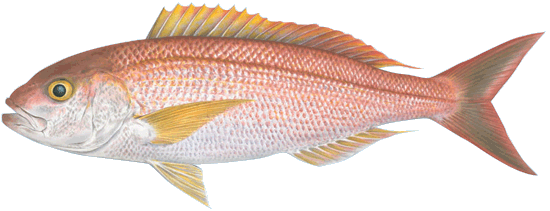
PINK SNAPPER (OPAKAPAKA)
Scientific Name: Pristipomoides filamentosus
Hawaiian Name: Opakapaka
Japanese Name: Kinme Himedai; Ohimedai
Opakapaka is also known as the Hawaiian pink snapper, although its skin is light brown. Found at depths between 180 and 600 feet, fish caught over hard bottoms have brighter skin colors than those caught over soft bottoms.
When properly cared for, opakapaka has a long shelf life. It has a clear, light pink flesh with a delicate flavor that has earned it the reputation as Hawaii’s premium snapper. Fish caught during the winter months tend to have a higher fat content than those caught in the summer, and opakapaka yields the best sashimi during the winter.
Opakapaka range in size from 1 to 18 pounds. It grows larger in the Hawaiian Islands than anywhere else in the South Pacific. Opakapaka are harvested exclusively with vertical hook-and-line gear.
FISHING METHOD
All Hawaii opakapaka are line-caught. All opakapaka are caught by deepwater handline gear with power reels.
SEASONALITY
Caught year-round in the Hawaiian Islands, there is a distinct peak in landings during the winter season (October-February), particularly in the fishery around the main Hawaiian Islands.
PREPARATION NOTES
Texture: Firm
Flavor: Delicate
Suggested Preparations: Raw (sashimi), Baked, Steamed, Poached, Sautéed, Soup
In Hawaii, smaller-sized fish is often prepared whole by steaming or baking. Also for soup and sashimi. Opakapaka fillets are well suited for an array of preparations, including baking, poaching and sauteing.
HEALTH & NUTRITION
Hawaii Pink Snapper is an excellent source of healthy, extra lean protein. It is also low in saturated fat and low in sodium. It is rich in niacin, vitamin B6, vitamin B12, phosphorus, and selenium. Hawaii Pink Snapper also provides about 275 mg of omega-3’s (DHA and EPA) per 4 ounce serving of fresh fish. Click here for nutritional labels and claims.
Click here to download a two-page description of this species.

